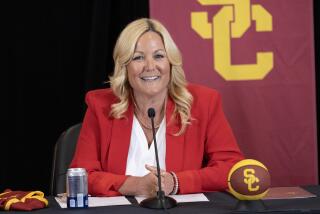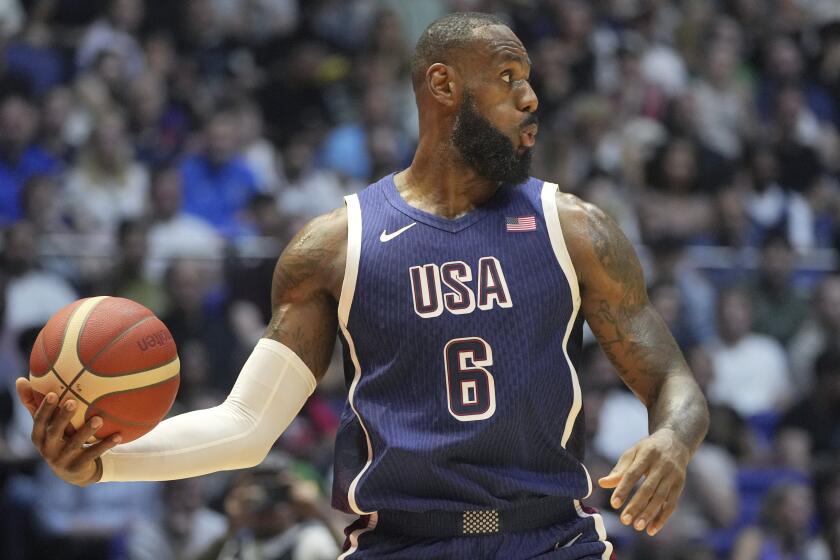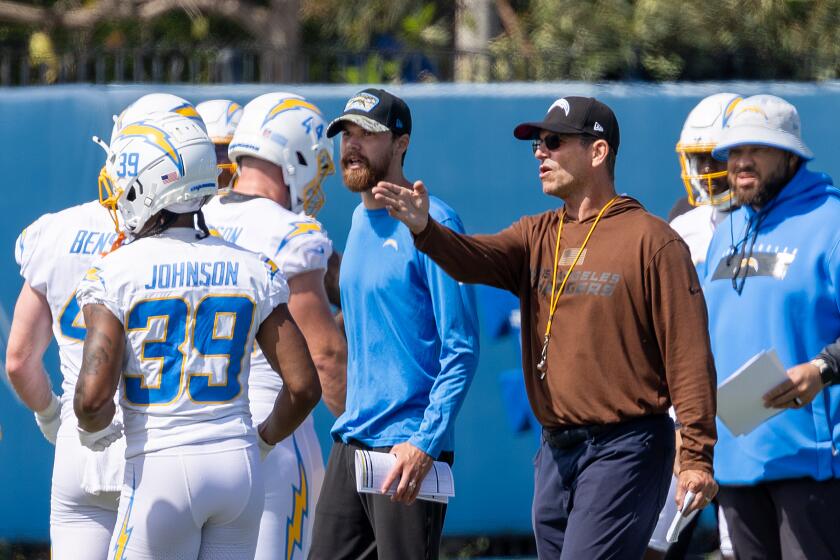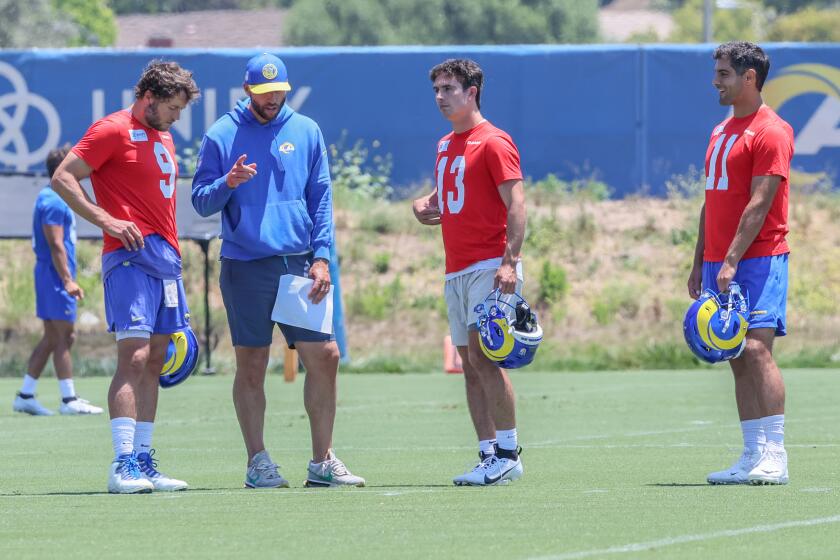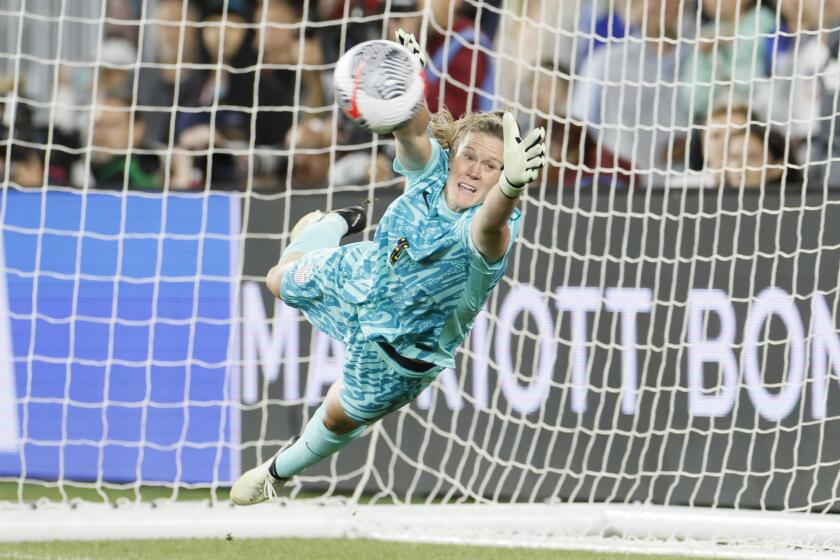MOVIES : Back From the Bonfire : After his disastrous last outing, Tom Hanks took some time off; now he’s playing against type as a besotted baseball manager
It was not the way Tom Hanks was accustomed to seeing himself on screen. He’d put on nearly 20 pounds to play washed-up big league ballplayer Jimmy Dugan in “A League of Their Own,” the story of an all-female professional baseball league formed during World War II. Dugan is a pathetic bloated drunken wretch who urinates in sinks, has tobacco spit drooling from his chin and, when introduced for the first time as manager of the Rockford Peaches, contemptuously mutters to the crowd, “You can all kiss my ass.”
When Hanks, watching complete scenes for the first time as he re-recorded dialogue, saw his puffy, bleary-eyed figure, he was amazed at how awful he looked. “They’d put me in a really boxy suit for the first scene and I looked like a behemoth,” he says, shaking his head at the memory. “I had rolls of fat on my neck. And my fingers . . . I looked ham-fisted in that thing.”
You look at Hanks--who is eating a Caesar salad and has long since dropped the excess poundage--and expect him to say something about how humiliating the whole thing had been. He doesn’t.
“When I saw it,” he says instead, “I was really pleased.
“The reason I got as heavy as I did was to give the audience a sense that this guy, when he was in shape, had really been an athlete. I didn’t want him to have my skinny little wrists and pipe-cleaner neck. I didn’t want him to look like me.”
Had it been up to Hanks, he would have made Dugan even seedier, more desperate. As the film goes on, the paunchy manager slowly emerges from his self-pitying stupor and--because “A League of Their Own” is, after all, a feel-good summer movie--he comes to admire and respect the women who play for him, particularly all-star catcher Dottie Hinson (played by Geena Davis). Through their success, Dugan finds a degree of redemption for himself.
“At the end of the movie,” Hanks says, “it shows that he lived until 1987. I would say, kill him in 1962, have him completely succumb to his depression and his alcoholism. Have him die in some bad cold-water walk-up in Truckee, Calif.”
Why, Hanks is asked. Why could such a grim ending appeal to you?
“Because,” he says, grinning, “I never get to play guys like that.”
For the record, Hanks would like to dispel two ongoing myths about the making of “A League of Their Own” last summer:
Myth No. 1 (perpetuated by studio publicists): That the actresses (including Davis, Madonna, Lori Petty and Rosie O’Donnell) had to pass a rigorous baseball tryout, including tests of their running, throwing and fielding skills. And that those who were somewhat lacking when filming started had become legitimate ballplayers by the time it was over.
“No more than Superman could really fly,” says Hanks, when asked if most of the actresses could actually play baseball. “This absolutely required the magic of motion picture making.”
Not that there weren’t exceptions. “Rosie O’Donnell? Excellent player. Lori Petty became a fierce pitcher. Robin Knight is a baseball player, pure and simple. And Freddie Simpson is so authentic a baseball player that she dipped Skoal.”
Myth No. 2 (perpetuated by Madonna): That Evansville, Ind., is a dreary, boring, horrible place, devoid of culture, restaurants or places to vogue.
“I’ve made movies in the equivalent of damp airplane hangars for three months at a time,” Hanks says, “so it was a pleasure to be out on the grass, with the open air, a place to sit down and a diet root beer always handy. There was always somebody to talk to, always some place to go play catch. It was a pleasure.
“I was there with my wife and my kids. We stayed in a beautiful house on five gorgeous acres with a pond. We loved the place. We loved going to the Dairy Queen and getting a chocolate cone on Thursday nights.”
There were, Hanks admits, a few problems. Like the guy who drove a tractor up to his front door, hauling 30 people on a hayride and getting a little miffed when Hanks declined to come along. And yes, he did have to hire security guards to keep people from ringing the doorbell to ask if they could take a picture. And, because of that, word apparently got out that Hanks wasn’t as neighborly as some folks thought he should be.
“Every now and again,” Hanks says, shrugging it off with a smile, “people would drive by and flip us the bird.”
Movie audiences haven’t seen Tom Hanks since December of 1990 and very few people saw him then. The spectacular flameout of Brian DePalma’s “The Bonfire of the Vanities” left a mark on everyone associated with the project, Hanks included. There were second-guessers everywhere, wondering why he would even attempt the part of doomed bond trader Sherman McCoy.
“I did everything I could to make it work,” Hanks says, acknowledging that, even before he signed on, the odds had been heavily against making a successful film adaptation of Tom Wolfe’s complex novel. “And the fallout from it was that it makes you reflect for a while. You question yourself. But what can you do? You take your shots and you swing away. You can’t go back and correct it or change it. You wish it had been different, but it’s not.
“It just solidified what William Goldman said a long time ago, that there’s only one commandment in Hollywood: Nobody knows anything. And that includes me.”
In light of “Bonfire’s” failure, some of Hanks’ advisers questioned whether “A League of Their Own” was the best choice for his return to the big screen. Even though he’d be reuniting with director Penny Marshall (who directed him to his Oscar-nominated performance in 1988’s “Big”), they questioned whether he should take a character part in an ensemble cast. They questioned whether at age 36 he was old and grizzled enough to play a has-been athlete. And, sounding a refrain that Hanks had heard before, they questioned whether he should play a character so “unlikable.”
“Likable,” Hanks says, pronouncing the word with a bite, “can be a terrible burden to put on someone. It ends up permeating everything you try to do.”
Tom Hanks would be the last one to complain about his “nice guy” screen image because he is, in fact, a nice guy. He knows his puppy-dog face and adolescent gangliness is a big part of what has endeared him to audiences since they watched him pursue a not-so-little mermaid in 1984’s “Splash,” his first major film role. But that same boyish charm and aura of easygoing innocence has also made it harder for him to be accepted in riskier, more substantive parts.
“I’m not a chameleon. This is the way I look and this is the way I sound and this is the way my body moves. I can’t alter that too much,” Hanks says, admitting he understands why a studio executive might be more inclined to cast him as “the wacky zookeeper” than “the bare-knuckled drill instructor.”
“I think I have a pretty good handle on myself as an entity, in regard to commerce,” Hanks says. “My strength is I’m funny. I naturally make people laugh, although not necessarily out loud. A guy wrote about me surfing once and he said if you were to watch this guy surfing, it would make you laugh. I know exactly what he’s talking about. There’s just something about me.
“But James Stewart was funny too. The thing was you still believed him when his character rebuilt the plane and flew it out of the desert. I think I can do that, too. What I’m saying is, you can’t just play to your strengths all the time. You can’t just play to the easy thing.”
After his performance in “Big,” the number of scripts Hanks was offered went up dramatically. The range of roles did not. “That just kind of fed the flames,” he says, “of stories about ordinary guys in extraordinary circumstances.” And, for the first time, Hanks was discovering how restrictive fame can be.
“When that happens,” he says of the 1988 rush of publicity that included being on the cover of Newsweek, “you are pegged. You are defined, whether you like it or not. There is still an overall take on you that gets planted and there’s nothing you can do to change it. If you do try to change it, they’ll just say, ‘Hey, you’re just trying to change your image and you’re not fooling us ‘cause we know you’re a likable nice guy.’
“And if you do the same thing again, if you do something that’s just likable and nice, they’ll say, ‘He’s just doing the same old stuff he’s always done.’ So, you can’t win.”
Still, Hanks tried. His first film to be released after “Big” was “Punchline,” in which he played a bitter, insecure stand-up comic. Critics applauded but the box-office receipts were lackluster. To this day, Hanks thinks “Punchline” is the best work he’s done. “It was the first time I saw myself in a movie and thought, ‘I don’t know who that guy is.’ ”
The movies that followed--”The ‘Burbs,” “Turner & Hooch,” “Joe vs. the Volcano” and, finally “Bonfire”--received, at best, lukewarm audience response. It was a downturn that Hanks saw as almost inevitable.
“I remember going through that phalanx of TV cameras at the (1988) Academy Awards and somebody says, ‘It’s gonna be hard to live this year down, isn’t it?’ I said then that I know a year like I’d had comes once every 15 years if you’re lucky, once every 10 if you’re amazingly lucky and once every five if you’re a phenomenon and I’m not laying any claim to being that. I just knew that it had been wild and that it would probably fall apart somewhere on down the line. I said that I’d feel bad about it for a while when it happened, but that in the end I’d be OK.”
It “happened,” of course, with “Bonfire.” Soon after, it was announced that Hanks had changed management and signed on with CAA superagent Mike Ovitz, a change he says he’d been contemplating for several years. And no, Hanks says, his first reaction to “Bonfire’s” crash and burn was not to go searching for safe haven in a “likable” role.
“If this was science and I was putting my career in the hands of the Republican National Committee, then that’s exactly what I’d do,” he says. “But you can’t plan things that way. You can’t say, well, first we’ll do this and then we’ll do that. If that worked for one person out of 115,000, it was totally by accident.”
Neither was there any strategy involved in the 19-month gap between the release of “Bonfire” and “A League of Their Own,” although Hanks is glad it happened. “I’ve made 15 movies since 1983,” he says, “and that’s too much.
“I had worked myself into a hole,” he says, explaining why he welcomed the break, “and I also think there was a chance the American public was gonna get so sick of looking at me. I’d been out there with a new movie every spring and again every summer for a lot of years and you can easily overstay your welcome. So it’s good to go away for a while.”
Hanks’ next break won’t be so long. In two weeks, he starts shooting “Sleepless in Seattle,” with co-star Meg Ryan for director Nora Ephron, a romantic comedy for TriStar Pictures in which Hanks plays a widower whose son uses a call-in radio show to help find his dad a new wife. The character, according to Hanks’ publicist, is likable.
More to Read
Go beyond the scoreboard
Get the latest on L.A.'s teams in the daily Sports Report newsletter.
You may occasionally receive promotional content from the Los Angeles Times.

